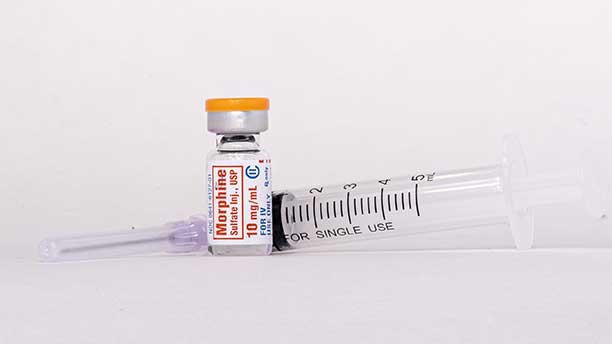Morphine Addiction | Morphine In Ohio

Medically Reviewed By: Kimberly Langdon, M.D.

Morphine is a naturally derived opiate pain reliever (analgesic) made from the opium poppy. It’s a prescription drug that treats moderate to severe pain and may be used for pain relief after surgery.
Discovered at the beginning of the 19th century, morphine was thought to be a less addictive alternative to opium. It turned out to be just as dangerous and paved the way for the invention of heroin.
Today, morphine is a Schedule II controlled substance with a high potential for abuse that can lead to addiction and physical dependence.
Effects Of Morphine
Morphine provides pain relief by changing the way your brain perceives pain. It targets opioid receptors, boosts dopamine levels, and gives you a pleasurable feeling of calm and euphoria.
As a central nervous system depressant, morphine slows your brain activity and relaxes your muscles, breathing, and heart rate.
Morphine can produce side effects, such as:
- drowsiness
- dry mouth
- headaches
- mood changes
- vision changes
- nervousness
- pinpoint pupils
- painful urination
- constipation
Severe morphine side effects may include:
- difficulty breathing or swallowing
- swelling of the face, eyes, mouth, lips, or throat
- hives, rash, or itching
- extreme sedation
- loss of coordination
- changes in heartbeat
- decreased sexual desire or ability
- nausea and vomiting
- loss of appetite and weight loss
- seizures
- hallucinations
Tell your doctor if you have severe side effects or persistent side effects that interfere with your daily life. Morphine abuse may increase the severity and frequency of side effects.
Long-Term Effects Of Morphine Use
Morphine is typically prescribed for short-term treatment, as opioids are very addictive and can be harmful to your health.
Research shows that long-term morphine use increases the risk of:
- Bone fractures: Morphine use can cause the bones to become weak, lose mineral density (osteopenia) and turn brittle (osteoporosis).
- Infections: Morphine suppresses the immune system, making you more vulnerable to infections and illness.
- Cardiovascular problems: Opioids like morphine can cause low blood pressure (hypotension), heart attacks, irregular and rapid heart rate, or a fluid buildup in the lungs.
- Sleep disturbances: Long-term morphine use can cause you to wake more and shorten your sleep cycles. It can also impair your breathing during sleep, leading to sleep apnea and other breathing issues.
- Bowel dysfunction: Constipation is a common side effect of opioid use that can lead to abdominal pain and bowel obstructions (blockages that make it impossible to have a bowel movement).
Signs Of Morphine Abuse
If you’re worried that a loved one is abusing morphine, don’t ignore the problem. Drug abuse can lead to addiction and cause devastating effects on a person’s life and health.
While morphine is an effective pain reliever that can help people through injuries or post-operative healing, it’s usually prescribed short-term. If you notice your loved one taking morphine for more than a couple of weeks, there might be a problem.
Signs of morphine abuse include:
- needing morphine to get through the day after the prescription runs out
- multiple morphine prescriptions from different doctors during the same period
- borrowing or stealing money to buy morphine
- excessive sedation
- secretive behavior
Drug Paraphernalia
Drug paraphernalia may also be a sign of morphine abuse. Morphine comes as an oral solution, liquid injection, tablet, or capsule. While some people abuse it orally, injecting morphine is traditionally the most common method of morphine abuse.
You might find syringes and morphine vials among a person’s possessions if they’re abusing the drug. People who inject drugs often use surgical tubing as a tourniquet to tie around their arms and expose the vein.
Unmarked vials, pill bottles, or small bags of morphine tablets are signs that a person is taking the drug without a prescription.
Morphine Overdose Risk
If you abuse morphine, you risk overdosing, which can be deadly. Opioid overdose is one of the leading causes of drug-related deaths in the United States today.
You can overdose by taking a high dose of morphine, taking overlapping doses, or mixing it with other drugs. Other central nervous system depressants—opioids, alcohol, and benzodiazepines—can cause severe respiratory depression when combined with morphine.
Morphine overdose symptoms are:
- excessive drowsiness
- difficulty breathing
- cold, clammy skin
- blue skin, lips, or nails
- tiny pupils
- slow heart rate and breathing
- loss of consciousness
- coma
If you catch it in time, you may be able to slow down a morphine overdose with naloxone (Narcan), an opioid overdose reversal agent. Naloxone blocks opioid receptors to reverse overdose symptoms and buys you time to get medical assistance.
Morphine Withdrawal & Detox
After taking morphine for a few weeks, your body will develop a physical dependence on it. If you suddenly stop morphine use, you’ll have withdrawal symptoms, which can be unpleasant.
Morphine withdrawal symptoms may be:
- anxiety
- insomnia
- sweating
- muscle aches
- stomach cramps
- diarrhea
- nausea
- vomiting
- large pupils
- goosebumps
The opioid withdrawal process makes it hard for people to stop abusing morphine, which traps them in the cycle of addiction.
A medical detox program can help. Medically assisted detox is an inpatient service that ensures your safety and relative comfort during morphine withdrawal.
You’ll be monitored around the clock in case complications arise. You may be given medications—such as over-the-counter pain relievers—to ease withdrawal symptoms and make the process more bearable.
Morphine Addiction Treatment In Ohio
Morphine addiction treatment can help you stop abusing morphine and live a more meaningful life. The goal is to improve your mental health and replace substance abuse with healthier behaviors through stress management, counseling, and evidence-based therapies.
Behavioral therapy is a common treatment option for opiate addiction, along with:
- support groups
- exercise and recreation
- yoga and meditation
- art therapy
- stress reduction techniques
- anger management
- addiction education
Medication-Assisted Treatment
Many people with opioid addiction can benefit from medication-assisted treatment (MAT). MAT combines evidence-based therapies with medication that reduces withdrawal symptoms and cravings.
People who completely detox from morphine before treatment may have strong cravings that interfere with their treatment progress. Many of them relapse or drop out of treatment.
MAT replaces the potent opioid with a milder drug, like methadone or buprenorphine. Research shows that MAT increases treatment retention and recovery success.
At Ohio Recovery Center, we offer medically assisted detox, medication-assisted treatment, and a variety of proven opioid treatment options. Talk to one of our treatment specialists today to learn more and start healing now.
FAQs
How Long Does Morphine Stay In Your System?
Morphine can stay in your system for an average of 10 hours. Drug testing methods, including urine tests, can detect morphine use for an average of 3 days after the last dose.
Learn more about How Long Morphine Stays In Your System
How Much Does Morphine Cost On The Street?
Morphine typically costs between $0.30 and $0.45 per milligram (mg) on the street. That’s $4.50 to $6.75 per 15 mg pill. The street price of morphine can be affected by your location, drug availability, how much you buy at once, and whether it’s adulterated or pure.
Learn more about Morphine Street Prices
- Department of Justice/Drug Enforcement Administration - Morphine https://www.dea.gov/sites/default/files/2020-06/Morphine-2020.pdf
- Dovepress - Less Well-Known Consequences of the Long-Term Use of Opioid Analgesics: A Comprehensive Literature Review https://www.dovepress.com/less-well-known-consequences-of-the-long-term-use-of-opioid-analgesics-peer-reviewed-fulltext-article-DDDT
- National Library of Medicine: MedlinePlus - Morphine https://medlineplus.gov/druginfo/meds/a682133.html

